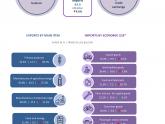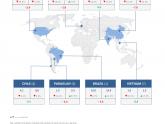Tuesday, 21 November 2023
In the first ten months, exports totalled US$ 56.6 billion and imports amounted to US$ 64.0 billion. The trade balance recorded a deficit of US$ 7.4 billion.
Highlights
- Between January and October, exports accounted for US$ 56.6 billion, which implied a year-on-year contraction of 24.8%, explained by a fall of 16.7% in quantities and 9.6% in prices.
- Imports amounted to US$ 64.0 billion and fell 9.6% in year-on-year terms, as a result of a 7.0% drop in prices and 2.8% in quantities. This is mainly due to lower prices and imported quantities of Fuels and lubricants. On the other hand, the imports of Parts and accessories for capital goods increased, due to higher quantities and price rises. In the case of Motor vehicles, the increase in prices failed to compensate for the fall in quantities..
- The trade balance recorded a deficit of US$ 7.4 billion, resulting from the greater contraction of exports than of imports. In the first ten months of 2022, a surplus of US$ 4.5 billion had been reached.

- The most significant falls in exports occurred in products such as: wheat (−US$3.2 billion), soybean flour and pellets (−US$ 3.1 billion), corn (−US$ 2.6 billion), crude soybean oil (−US$ 2.4 billion), soybeans (−US$ 1.8 billion) and biodiesel (−US$ 1.2 billion). The largest increases were recorded in soybean oil −excluding crude− (US$ 249 million), motor vehicles for the transport of persons (US$ 235 million), motor vehicles for the transport of goods (US$ 221 million), natural gas in gaseous state (US$ 139 million) and lithium carbonate (US$ 131 million).
- In relation to the soybean complex, the prices of flour and pellets increased by 2.4%, while those of crude oil (−29.2%), biodiesel (−19.1%) and beans (−8.2%) decreased. As for the quantities exported, falls were recorded in those of biodiesel (−74.5%), beans (−62.0%), flour and pellets (−32.8%), and crude oil (−20.2%).
- Regarding imports, the largest purchases of soybeans (US$ 3.0 billion) and iron or steel pipes used in oil and gas pipelines (US$ 209 million) stand out , while those of gas oil (−US$ 2.4 billion), liquefied natural gas (−US$ 767 million), natural gas in gaseous state (−US$ 727 million); and urea (−US$ 436 million) decreased.

- The three main partners, Brazil, China and the United States, represented as a whole 34.1% of the exports and supplied 55.2% of the imports. In turn, the share of the European Union was 10.3% of shipments and 14.3% of purchases.
- The highest surpluses were obtained in trade with Chile (US$ 3.4 billion), Peru (US$ 1.9 billion), Uruguay (US$ 927 million) and India (US$ 866 million); while the largest deficits were recorded with China (−US$ 7.8 billion), Brazil (−US$ 5.4 billion), the United States (−US$ 2.9 billion), Paraguay (−US$ 2.3 billion), Germany (−US$ 1.8 billion) and Thailand (−US$ 1.3 billion).
Related documents:




